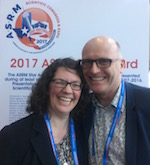ASRM2017: progress in endometriosis, but a vital step is missing
Data and studies presented at ASRM2017 made it clear that the ongoing challenge in endometriosis remains identification of the elusive phenotypes – or sub-groups – of the disease to determine what treatments work for whom.
 Whereas exciting studies were presented at this year’s meeting in San Antonio (TX), USA, these studies are often not reproducible in other cohorts, because we don’t know why certain groups of women with endometriosis react to certain treatments – or have certain symptoms or ways in which the disease behaves in their bodies.
Whereas exciting studies were presented at this year’s meeting in San Antonio (TX), USA, these studies are often not reproducible in other cohorts, because we don’t know why certain groups of women with endometriosis react to certain treatments – or have certain symptoms or ways in which the disease behaves in their bodies.
This overall conclusion from ASRM2017 was summarised by the World Endometriosis Society’s president, Neil Johnson:

WES treasurer, Stacey Missmer, and WES president, Neil Johnson, at the ASRM in San Antonio, October 2017
It is heartening to see all the exciting new scientific and clinical studies, many of which have enormous potential. However, it is more and more apparent that it is not as simple as having endometriosis.
It is the particular phenotype of endometriosis that will determine a woman’s response to various treatments – in relation to dealing with all the symptoms of endometriosis.
It really is becoming profoundly apparent that the way forward is that of precision medicine targeted at specific ‘phenotypes’ (sub-types) of endometriosis.
said, Dr Johnson.
These phenotypes will no doubt be identified as WERF EPHect gathers comparable data through its now extensive global collaborative network.
Until then, however, it is worth highlighting a few studies presented at the ASRM, which certainly showed promising results – both longer term and, potentially, imminent.
Biomarkers and inflammation in endometriosis
 The Endometriosis Special Interest Group (EndoSIG) not only evaluates abstracts submitted to the ASRM and ensure our field is well represented in the overall programme, but also awards prizes to the top papers, thanks to a prize fund created by Dr Dan Lebovic.
The Endometriosis Special Interest Group (EndoSIG) not only evaluates abstracts submitted to the ASRM and ensure our field is well represented in the overall programme, but also awards prizes to the top papers, thanks to a prize fund created by Dr Dan Lebovic.
This year these were both from teams from the Yale University School of Medicine, under the supervision of Dr Hugh Taylor:
EndoSIG basic science prize paper
ENDOMETRIOSIS ALTERS ANXIETY, DEPRESSION, AND PAIN PERCEPTION AS WELL AS BRAIN ELECTROPHYSIOLOGY AND GENE EXPRESSION IN MICE
Mamillapalli et al demonstrated higher levels of anxiety and depression, as well as pain sensitisation, in mice that were induced to develop endometriosis compared to mice without endometriosis-like lesions. Additional testing of biologic changes in the mice, who demonstrated these symptoms, may suggest targets for future studies in women.
EndoSIG clinical/population science prize paper
SERUM MICRORNAS USED TO DIAGNOSE ENDOMETRIOSIS PRIOR TO SURGICAL DIAGNOSIS: A PROSPECTIVE STUDY
Moustafa et al’s study included 36 women with endometriosis and 50 with pathology that was not endometriosis. Analyses of serum samples identified two microRNAs that were higher in the women with endometriosis. Sub-analyses suggest that these may be elevated primarily in stage III/IV disease, but studies are ongoing. These findings, if replicated, may identify potential biologic processes associated with these microRNAs as well as a step toward a non-surgical diagnostic test.

Professor Hugh Taylor, Yale School of Medicine
Our findings show that many of the behavioural and mood alterations seen in women with endometriosis are indeed caused by endometriosis. This should end the inappropriate stereotypes that have been associated with the disease. Endometriosis causes widespread systemic manifestations.
Endometriosis is often misdiagnosed and not identified for years. A biomarkers will allow for early diagnosis and treatment in order to prevent the long term damage caused by this disease.”
said, Professor Taylor.
A new medical treatment for endometriosis (Elagolix)?
At the 13th World Congress on Endometriosis, we reported on promising data from two replicate phase III studies evaluating elagolix – an oral GnRH-antagonist.
At ASRM2017 four teams presented data from extended studies using this drug, ie. studies where women had continued treatment for an additional six months beyond the original six month study period to evaluate the longer-term safety and efficacy of elagolix.
The reduction in moderate-to-severe non-menstrual pain, as well as painful sex (dyspareunia), was maintained over the 12 month period – without any change to these women’s side-effect profile (and, importantly: without anyone dropping out of the study) – regardless of whether they were on the 150mg once daily or 200mg twice daily dose (though the higher dose was associated with better results when it came to painful sex).

Dr Eric Surrey
Medical director of the Colorado Center of Reproductive Medicine
One of the potential advantages of this upcoming drug is that it can be titrated. This means that the daily dose received can be adjusted to fit each woman’s needs in a sort of “we can try this until it works for you” way, which is unusual in hormonal treatments for endometriosis.
Eric Surrey, a study investigator, said:
The results presented today are positive for women and are consistent with previous data that demonstrate elagolix has the potential to be an important non-surgical treatment option for women suffering from the most prevalent symptoms of endometriosis.
Endometriosis summary from ASRM2017
The ASRM EndoSIG chair, Stacey Missmer, summarised highlights from the 73rd Annual Meeting of the ASRM:
There were two paper presentation sessions held at this year’s meeting that included the prize winning and highlighted studies described above.
The breadth of topics being studied was impressive in both basic science and studies of women within the US and across the globe. In addition, leading surgeons presented several videos and led training discussions to advance the skills of our next generation of endometriosis-focused surgeons.
A high point of the meeting was the very well attended debate between two clinical scientists, who have focused much of their careers on treating women with endometriosis and answering questions that remain to improve their care. Dr Bruce Lessey’s argument was deemed most compelling – arguing that endometriosis has an impact on in vitro fertilisation success and thus defeating Dr Kurt Barnhart’s attempt to convince the audience that it does not.
Once again, the resounding theme of the lengthy discussion that followed was the importance of discovering endometriosis sub-groups, ending the one-size fits all approach, and developing personalised medicine options.
said Dr Missmer.

The ASRM EndoSIG (left to right): Chair, Stacey Missmer; Past Chair, Bruce Lessey; Past-past Chair, Hugh Taylor; Vice-chair, Steve Young; Vice-chair-elect, Kaylon Bruner-Tran, at ASRM2017 in San Antonio (TX), USA






